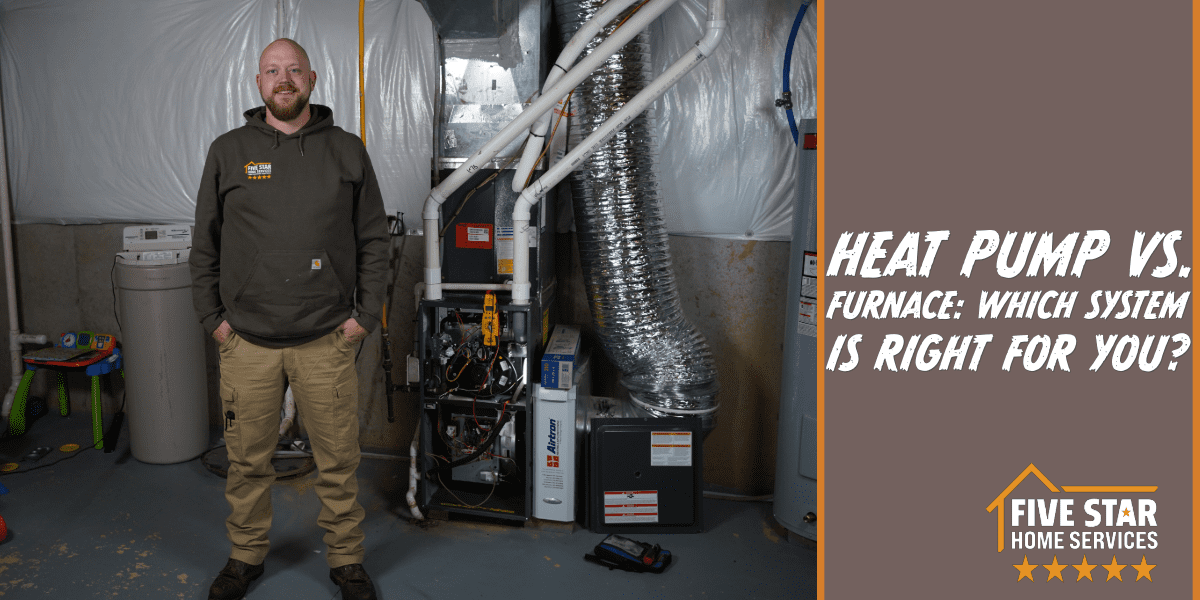Deciding on whether to install a new furnace or go with a heat pump doesn’t have to be a difficult decision. In the following article, we will look at the pros and cons of furnaces vs. heat pumps. If you’re a homeowner looking to decide to buy/replace one or the other, your friends at Five Star Home Services are always here to help! The following factors often come into this decision. Arming yourself with all the available information helps us make the best decisions in life. Home comfort equipment is no exception!
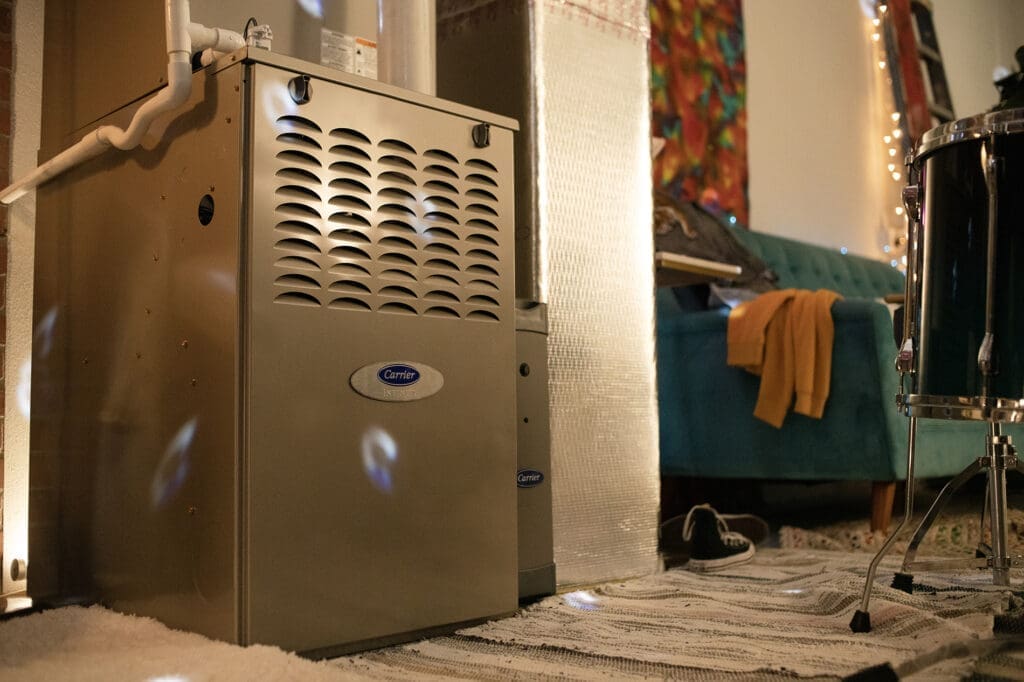
Although heat pumps and furnaces can both heat your home, it is important to know that they can do it in vastly different ways. When it comes to providing heat for your home, you have several options to consider.
Unless you have experience in HVAC systems and how they work, understanding how to choose the right heating system for your home can feel overwhelming. Don’t worry!
Your friends at Five Star Home Services, have more than 50 years of experience in the HVAC industry. By leveraging that experience, we hope to answer questions as quickly and as thoroughly as possible.
In the following article, we present information to help you make the most informed decision. If you aren’t prepared to make a major purchase, you will at least have a good understanding of heat pumps and home heating systems. When you are ready, we are always ready to help as well.
In this article, we break all this down by discussing the following topics:
· What’s a Heat Pump?
· What’s a Furnace?
· What’s a Dual Fuel System?
· Variable-Speed Fans
· If You’re Looking to Replace Your Furnace or Heat Pump
· Why You Might Not Want a Heat Pump
· Which Will Last Longer: Electric or Gas?
· What’s the Best Option for Ohioans?
· What Will a New Heat Pump or Furnace Cost Me?
· Next Step: Give us a call!
Now, are you ready to find out which system is right for you?
What is a Heat Pump?
During the summertime, heat pumps work as air conditioners. Heat pumps are merely air conditioners with reversing valves that automatically switch the unit from air conditioning to heating.
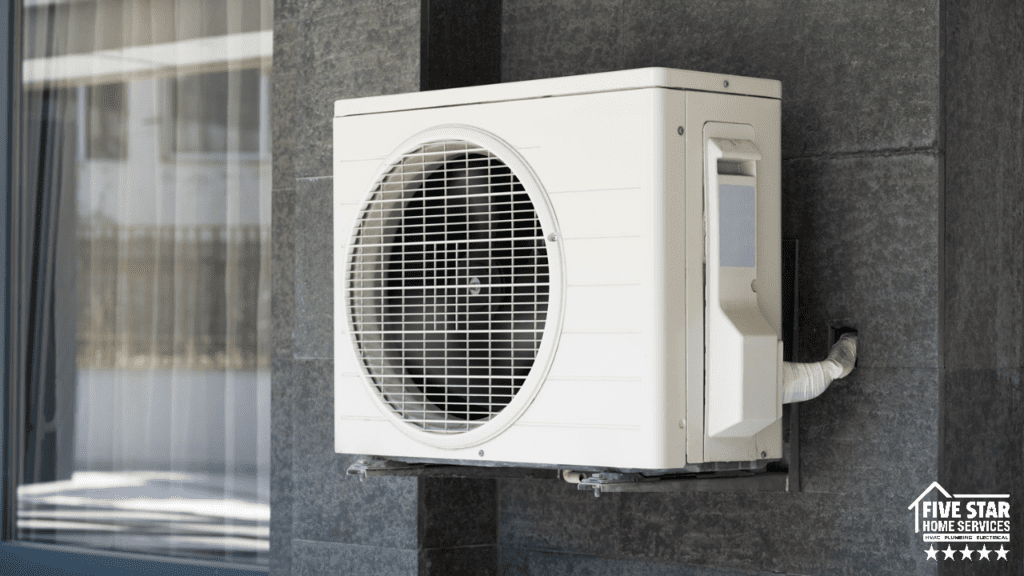
During the wintertime, heat pumps generate heat and work as furnaces. As soon as it gets cold outside, the unit’s reversing valve automatically switches to heating. This means the heat pump draws in the heat from the outside air and transfers it indoors into the home.
If you have an all-electric HVAC system, the heat pump’s heat can be complemented by heat strips inside the furnace. Heat strips are wire elements inside your air handler that are heated up by electricity — which in turn heats the air that flows over them.
Heat is then pushed throughout the ductwork by an air handler or by the furnace’s blower. Cool air is then sucked into the air handler through return ducts where it gets heated.
What Is a Furnace?
Now that we’ve defined a heat pump, we will now define a furnace. Furnaces are home heating systems that produce and distribute heat to warm up interior spaces. They operate by burning fuel, such as natural gas, coal, or oil, or by using electricity to generate heat. Eventually, this heat is circulated throughout a building or home via radiators or air ducts. Furnaces are an essential component of HVAC
(Heating, Ventilation, and Air Conditioning) systems, ensuring a comfortable indoor environment in cold weather conditions.
Furnaces come in different types. Each type of furnace has its own unique mode of operation. A single-stage furnace has one setting for heat output, providing the same amount of heat regardless of the outside temperature.
Two-stage furnaces have low and high settings, offering more flexibility and efficiency as they can adjust the heat output based on the demand. Modulating furnaces have the greatest efficiency overall as they continuously adjust the heat output and airspeed for the most optimal comfort and energy efficiency. Regardless of the type of heating system, regular preventative maintenance is essential to ensure it operates at peak efficiency and prolongs its lifespan. Remember always, that an ounce of prevention is worth a pound of cure.
In any case, the two most popular types of furnaces include gas and electric furnaces. Gas furnaces are the most common. They are also the most cost-efficient due to the low cost of natural gas. As the name suggests, gas furnaces are combustion appliances. You have a gas line (with a gas valve), an igniter, and different systems for capturing, separating and moving heat throughout your home.
Heat exchangers are one of the core components enabling the unit to extract heat for your home. Some high-efficiency gas furnaces use two heat exchangers. This enables them to extract more heat with less waste byproduct. Regardless of the number of heat exchangers you have, the byproducts of the combustion process will be vented out of the chimney flue. In high-efficiency gas furnaces, the exhaust goes out through a PVC pipe.
Alternately, electric furnaces are the main alternative to gas furnace heating systems. Using electric power to generate heat and derive its warmth through heat strips, which are like toaster ovens inside your electric furnace. The heat strips have an electric charge to them, air blows through them, and this heated air is what keeps the home heated.
What Is a Dual Fuel Heating System?
A Dual Fuel Heating System is a hybrid system that combines a heat pump with a traditional gas furnace. This versatile system operates by using the heat pump for heating when outdoor temperatures are mild. When the temperature drops significantly, the system automatically switches to use the gas furnace. This combination provides the energy efficiency of a heat pump with the heating power of a gas furnace, offering a cost-effective and environmentally friendly solution for heating homes and commercial spaces.
Dual fuel heating systems are an example of taking an adaptive approach to home heating. By selectively utilizing the most efficient fuel source based on the external temperature, homeowners can optimize their energy use and potentially reduce utility costs. Dual systems are designed with comfort and efficiency in mind, ensuring a steady, comfortable indoor climate regardless of how cold it gets outside. This system is particularly beneficial in places with extreme winter climates, where temperature fluctuations are common and energy costs can be high.
Variable-Speed Fans
There are three types of fans:
· Two-stage
· Single-stage
· Variable-speed
The majority of home heating systems have a single-stage fan, which is also called a blower. This means the unit is either “off” or “on.” It’s either working at 100% or not at all.
Two-stage motors have a 100% setting. They also have another lower setting (at about 70% power), which provides additional comfort and control. Although they are a nice middle ground between low-end and high-end efficiency — the initial cost saves you money on energy costs compared to a single-stage. You could look at it like gas mileage. While it is more efficient to drive at slower speeds rather than higher speeds — slamming the pedal creates long-term wear and tear. The benefits of having a second, slower stage is somewhat similar in terms of efficiency and system usage. They can have hundreds of individual speed settings that offer a very granular level of control over your home heating and air conditioning.
The same is true for heat pumps. There are also three types of fans for heat pumps. They include single-stage, two-stage, and variable-speed.
Variable-speed air conditioners have up to 700 distinct compressor settings, all of which correspond to varying levels of airflow. Variable-speed air conditioners perform the most efficiently. They are also the quietest as well. They often operate at speeds as low as 40% of their maximum power capacity.
Although you save the most on energy costs and have the greatest degree of control over the temperature in your home, the biggest downside is their initial cost. These systems aren’t cheap. However, they largely make up that cost in the long run.
Looking to Replace Your Furnace or Heat Pump?
If you’ve been thinking about replacing your furnace or investing in a new heat pump, you should consider whether your system is all-electric. If it is electric, you don’t have much choice. You probably have to replace them both, because the indoor and outdoor units on electric need to rate properly.
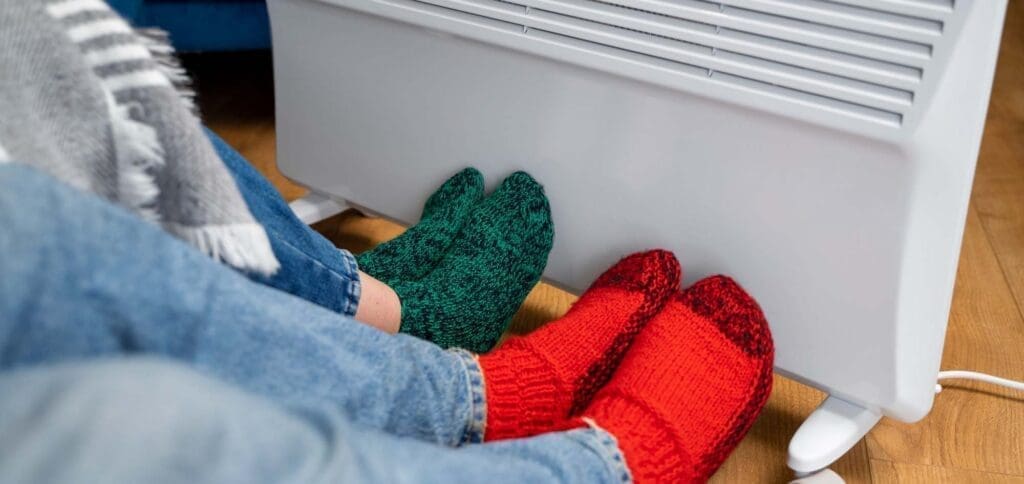
Ratings indicate the settings on the furnace’s fan match the available settings on your air conditioner. Otherwise, the A/C won’t function efficiently. This is also referred to as “equipment matching.” If equipment is mismatched, it won’t work together properly because it will not communicate well.
Blower motors in furnaces are what provide airflow for the entire system, including air conditioners. Motors need to be able to match the options inside the air conditioner for them to work well together. However, if you have an air conditioner with hundreds of speeds (variable speed) and a blower motor that can only turn on or off (single-stage), you’re wasting a lot. Your air conditioner isn’t performing at its potential.
With gas systems, you might never have to replace them because they are mutually exclusive. However, with all-electric systems, 99% of the time you replace them together. The indoor coil and the outside condensing unit must be similar and must also be rated by the Air Conditioning, Heating & Refrigeration Institute (ACHRI) for the warranty to cover them.
This boils down to homeowners needing to educate themselves about their options, and how those relate to price. If you have a variable-speed air conditioner and aren’t prepared to replace it — you will need a compatible furnace. Furnaces limit your options and put you squarely in a higher price category.
Conversely, if you’re thinking of upgrading to a variable-speed furnace, and your current full system only supports single-stage, you will either sacrifice energy efficiency, or you won’t be able to upgrade to the variable-speed unless you replace the entire system.
Reasons You Might Not Want to Buy a Heat Pump
Heat pumps have dual purposes. They provide heating and air conditioning. What are the reasons you might not want one? There are two main reasons:
The first is that the initial cost of heat pump installation is going to be higher than comparable air conditioners.
The second is that the efficiency of a heat pump’s heating is going to suffer in colder climates. Here in Central Ohio, it’s often necessary to combine it with an electric furnace.
That isn’t to say heat pumps aren’t great solutions. When paired with furnaces properly, heat pumps can provide extremely efficient heating and air conditioning. Nevertheless, the context matters.
If you reside in Central Ohio, and have nice, mild winters, installing a heat pump will probably work well. If you have a bitter cold winter, your heat pump will struggle. Heat pump effectiveness depends on the weather. It also depends on the type of heat pump. If it’s a single-stage, low-efficiency system — with a rating of 14 SEER or 16 SEER — it isn’t as efficient in the winter.
SEER, which stands for Seasonal Energy Efficiency Ratio, is calculated by the ratio of cool air generated by an air conditioner and divided by its energy usage in watt-hours. This ratio is calculated over the length of a typical cooling season. The SEER ratings in most modern air conditioners vary from 13 to 22 SEER. The higher the number, as always, the greater the unit’s efficiency. If you have a single-stage unit combined with an electric furnace, your furnace’s heat strips are going to have to come on when it’s nearly 40 degrees outside, which isn’t very efficient at all. At this rate, your electric bills will increase dramatically.
Although they aren’t as common up here in Ohio, in the southern and southwestern parts of the country, all-electric systems are much more popular due to the decreased need for high-powered heating. You’ll find a lot more heat pumps out there. However, here in Central Ohio, the lower cost of gas makes a centralized air conditioner combined with a gas furnace system the best option for the majority of homeowners.
Which Lasts Longer: Gas or Electric?
Next we’ll discuss the longevity of these systems. Electric systems work a lot harder than gas systems. Because of this, they also tend to have shorter lifespans. During the summer months, heat pump work like central air conditioners. During the winter, they generate heat. Any systems or equipment that is required to work more tends to have shorter lifespans.
However, when properly installed, the average expected lifespan of a heat pump is 15 to 20 years. The biggest caveat is that you need to have regular maintenance performed and you need to replace your air filters regularly. Make sure you aren’t pushing the unit to ridiculous levels.
What are ridiculous levels? Let’s say that during the summer you set your thermostat to 65 degrees. Then, during the winter, you set it to 78 degrees. In this case, you’d be making your HVAC system work too hard. However, if you keep your thermostat set to 70 degrees throughout the year, you shouldn’t have as many maintenance issues, and the unit will last longer.
What Are the Best Options for Central Ohioans?
Because of the cold winters, furnaces are usually preferable over heat pumps. Nevertheless, even the newest and most efficient, multiple-stage heat pumps still have their limitations. When the temperatures drop to 40 degrees Fahrenheit or below, heat pumps struggle to generate heat. At this temperature, you’ll need emergency heat from your furnace. Heat pump, however, can usually run when it’s 40 degrees or even as low as 20 degrees outside. However, when it gets to the point where the heat pump needs to defrost and there’s still a call for heat, something else has to step in. That’s when heat strips take over.
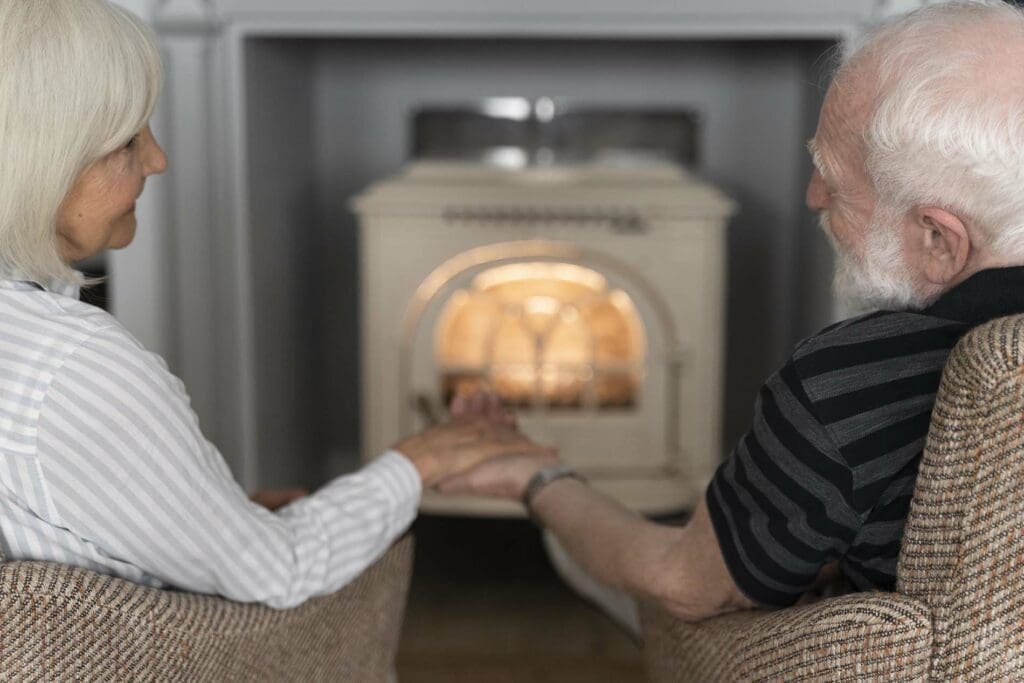
What Does a New Heat Pump or New Furnace Cost?
Next, we will explore costs for replacing a gas or electric furnace. Furnace prices range from between $3,999 and $6,500. For electric systems, you have to replace a heat pump, it can be anywhere between $4,900 and $12,500. Replacing both at the same time would save greatly on labor costs, but would obviously raise the price. At Five Star Home Services, our estimates include labor costs, the cost of equipment, as well as any additional fees.
When the time comes to replace your furnace, we feel it is very important for you to understand that you can always save money by pairing your furnace installation with a new central air conditioner installation. Having both of these replaced at once reduces labor costs greatly, compared to installing each of them separately at separate times. This cost savings can be thousands of dollars depending on the types of HVAC systems being installed. It’s always worth checking into. And as your local comfort experts, we at Five Star Home Services have you covered!
Doing them together also ensures that your equipment matches. We make sure everything synchronizes, including things like maintenance and warranties. If you are approaching your equipment’s replacement age for both your furnace and air conditioner/heat pump, this is probably your best bet. However, if only one of these systems requires replacement, half installations (furnace or A/C only) are also very common.
A good HVAC contractor like Five Star Home Services can walk you through each factor that influences the cost of your heat pump replacement. We also identify potential problems and make professional recommendations that influence the price of your system.
Additionally, like any reputable HVAC contractor, we always follow local building codes and adhere to strict manufacturer specifications to install your system properly.
Some of the factors affecting the cost of HVAC installation include the size of your home, filters, other indoor air quality products, and the types of modifications required during the installation. In any case, there’s never a one-size-fits-all solution when it comes to HVAC systems. These factors are taken into consideration when determining the overall cost.
We at Five Star Home Services follow several key processes to ensure your HVAC system’s comfort, efficiency, safety, and life expectancy. Any HVAC contractor that fails to follow all the necessary processes required by the manufacturer, local codes, and industry standards only lead to discomfort, high energy bills, and a drastically shortened life expectancy of the equipment.
A lot of HVAC contractors, we should note, don’t include labor or other fees in their estimates. Because of this, you could end up paying more than you planned.
We strongly suggest checking your contractor’s estimate to ensure it includes all additional costs.
What Next? Call Five Star Home Services!
Homeowners need to understand that the HVAC installation process is the single most important step for the safety and life expectancy of your HVAC system. This step is the difference between a long-lasting, efficient system and one that provides a sub-par performance.
While searching for the “best HVAC contractor near me,” we encourage you to give us a call to speak with one of our friendly representatives. We would love to help you find the best heat pump or furnace in your area.
At Five Star Home Services, we take the time to understand your needs and discuss all your comfort and air quality-related concerns. Doing so ensures we end up recommending HVAC equipment that can customize your needs to fit your lifestyle and preferences.
Call your friendly local HVAC experts at Five Star Home Services today at (833) 405-8009.

